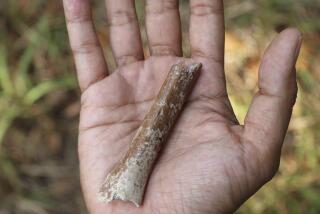Fossil teeth study takes bite out of Neanderthal-European link
Scientists seeking the missing link between modern Europeans and Neanderthals ought to head back to Africa, according to a new study that could prune some of the younger branches of the evolutionary tree.
Researchers took another look at a common fossil used to date early humans – teeth. By looking at the pattern of points on molars of European fossils, older African and Asian fossils, and modern humans, they arrived at a picture of what the teeth of a common ancestor might have looked like.
Photos: A New View of Early Human Ancestors
“What we realized is that none of the species we have in the fossil record is similar to that ancestor morphology that we calculated as the most likely one,” said Aida Gomez-Robles, an anthropologist at George Washington University and lead author of the study published online Monday in Proceedings of the National Academy of Sciences. “We think that we didn’t find it because we actually don’t have this ancestor in the fossil record.”
Paleontologists have offered various fossil finds as a candidate for the common ancestor to Europeans, paramount among them Homo heidelbergensis, a tall and strong species that wandered out of Africa less than 800,000 years ago, and which was named for the southwestern German city near which it was found.
Most DNA analysis places the split between Neanderthals and modern humans at roughly 400,000 years ago, give or take a few hundred thousand years.
But Heidelberg man’s teeth tell a different tale, Gomez-Robles said. They are too similar to those of the famed species named for a cave in the Neander Valley, farther north. “It shows clear dental affinity with Neanderthals, and we think the reason for this is that they are already in the lineage leading from Neanderthals.”
The missing ancestor ought to have teeth that look a bit more like the choppers of Homo ergaster, which wandered around eastern and southern Africa 1.3 to 1.8 million years ago, according to the study.
“We can rule out all the European species as possible ancestors, because they are already in the line leading to Neanderthals, and we have an African species, which is the most similar one to the ancestor morphology,” Gomez-Robles said. “So the most intuitive explanation is that some African species posterior to Homo ergastor will be the ancestor.”
The study suggested that ages derived from DNA modeling were underestimated. Alternatively, teeth may have started changing more rapidly for modern humans, or tooth shape was changing before such species diverged. Neither of those hypotheses is supported by the data or by commonly accepted models of evolution, Gomez-Robles noted.
A study published last week in the journal Science similarly shook the common view of the evolutionary tree, suggesting that several species dating to about 2 million years ago are instead one.







